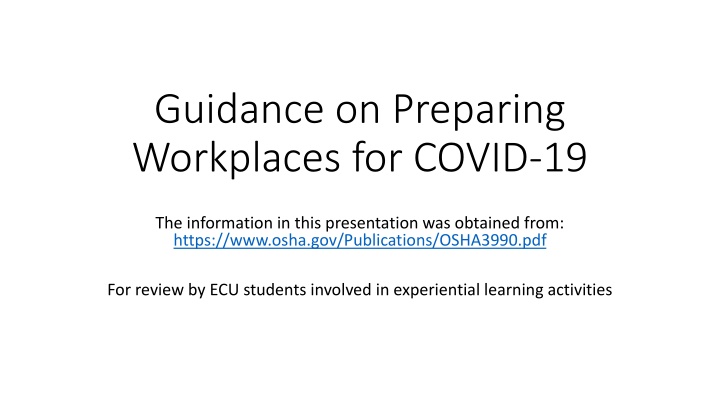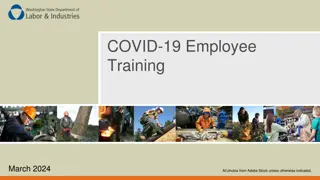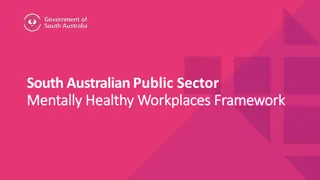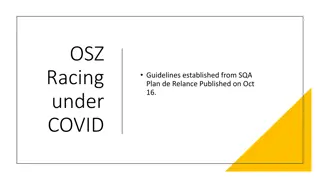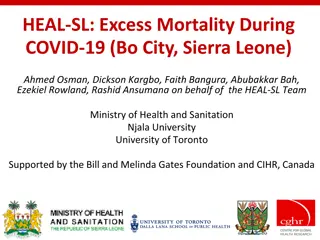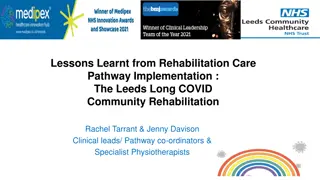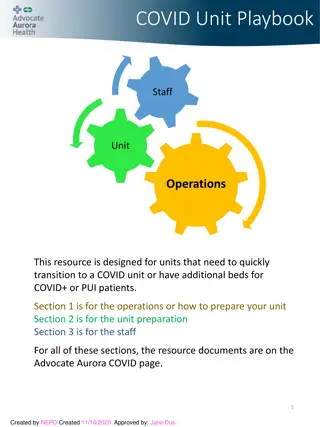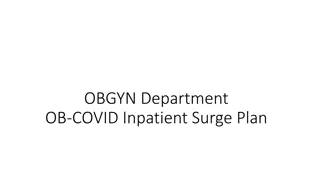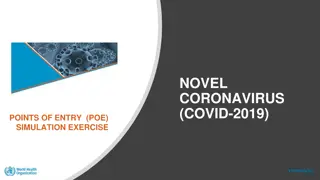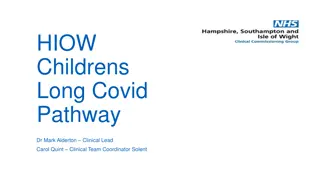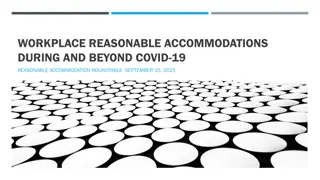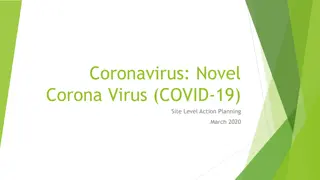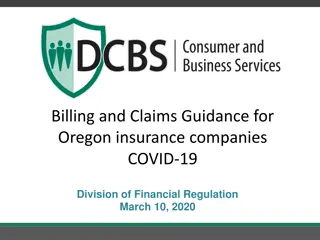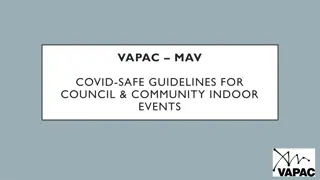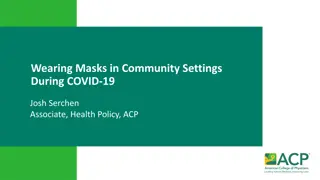Guidelines for Preparing Workplaces during COVID-19
This guidance, sourced from OSHA, emphasizes the importance of employers implementing controls and protective measures to reduce COVID-19 risks in workplaces. Students involved in experiential learning activities are advised to understand workplace risks and protocols for worker protection. Detailed information on COVID-19 symptoms and OSHA's Occupational Risk Pyramid is provided for better comprehension.
Download Presentation

Please find below an Image/Link to download the presentation.
The content on the website is provided AS IS for your information and personal use only. It may not be sold, licensed, or shared on other websites without obtaining consent from the author.If you encounter any issues during the download, it is possible that the publisher has removed the file from their server.
You are allowed to download the files provided on this website for personal or commercial use, subject to the condition that they are used lawfully. All files are the property of their respective owners.
The content on the website is provided AS IS for your information and personal use only. It may not be sold, licensed, or shared on other websites without obtaining consent from the author.
E N D
Presentation Transcript
Guidance on Preparing Workplaces for COVID-19 The information in this presentation was obtained from: https://www.osha.gov/Publications/OSHA3990.pdf For review by ECU students involved in experiential learning activities
Purpose As a student who is completing experiential learning activities off- campus, it is important that you understand workplace risk and strategies used to protect workers in the context of the COVID-19 pandemic OSHA has developed guidelines to help workplaces mitigate risks If you are ever concerned about conditions at your work site, you should contact your training site supervisor and program coordinator immediately
Guidance on Preparing Workplaces for COVID-19 The Occupational Safety and Health Administration (OSHA) developed this COVID-19 planning guidance based on traditional infection prevention and industrial hygiene practices. It focuses on the need for employers to implement engineering, administrative, and work practice controls and personal protective equipment (PPE), as well as considerations for doing so https://www.osha.gov/Publications/OSHA3990.pdf
Guidance on Preparing Workplaces for COVID-19 All students should review the guidelines in their entirety, with particular emphasis on guidelines for the anticipated work environment In addition to specific exposure level recommendations, review section entitled Steps All Employers Can Take to Reduce Workers Risk of Exposure to SARS-CoV-2 https://www.osha.gov/Publications/OSHA3990.pdf
COVID-19 Symptoms (check CDC link below for updates) People with COVID-19 have had a wide range of symptoms reported ranging from mild symptoms to severe illness. Symptoms may appear 2-14 days after exposureto the virus. People with these symptoms may have COVID-19: Cough Shortness of breath or difficulty breathing Fever Chills Muscle pain Sore throat New loss of taste or smell https://www.cdc.gov/coronavirus/2019-ncov/symptoms-testing/symptoms.html
Occupational Risk Pyramid for COVID-19 To help employers determine appropriate precautions, OSHA has divided job tasks into four risk exposure levels: very high, high, medium, and lower risk. The Occupational Risk Pyramid shows the four exposure risk levels in the shape of a pyramid to represent probable distribution of risk. Most American workers will likely fall in the lower exposure risk (caution) or medium exposure risk levels. https://www.osha.gov/Publications/OSHA3990.pdf
Lower Exposure Risk (caution) Lower exposure risk (caution) jobs are those that do not require contact with people known to be, or suspected of being, infected with SARS-CoV-2 nor frequent close contact with (i.e., within 6 feet of) the general public. Workers in this category have minimal occupational contact with the public and other coworkers. https://www.osha.gov/Publications/OSHA3990.pdf
Jobs Classified at Lower Exposure Risk (Caution): What to Do to Protect Workers Engineering Controls Additional engineering controls are not recommended for workers in the lower exposure risk group. Employers should ensure that engineering controls, if any, used to protect workers from other job hazards continue to function as intended. https://www.osha.gov/Publications/OSHA3990.pdf
Jobs Classified at Lower Exposure Risk (Caution): What to Do to Protect Workers Administrative Controls Monitor public health communications about COVID-19 recommendations and ensure that workers have access to that information. Frequently check the CDC COVID-19 website: www.cdc.gov/coronavirus/2019-ncov. Collaborate with workers to designate effective means of communicating important COVID-19 information. https://www.osha.gov/Publications/OSHA3990.pdf
Jobs Classified at Lower Exposure Risk (Caution): What to Do to Protect Workers Personal Protective Equipment Additional PPE is not recommended for workers in the lower exposure risk group. Workers should continue to use the PPE, if any, that they would ordinarily use for other job tasks. https://www.osha.gov/Publications/OSHA3990.pdf
Medium Exposure Risk Medium exposure risk jobs include those that require frequent and/or close contact with (i.e., within 6 feet of) people who may be infected with SARS-CoV-2, but who are not known or suspected COVID-19 patients. In areas without ongoing community transmission, workers in this risk group may have frequent contact with travelers who may return from international locations with widespread COVID-19 transmission. In areas where there is ongoing community transmission, workers in this category may have contact with the general public (e.g., schools, high-population-density work environments, some high-volume retail settings). https://www.osha.gov/Publications/OSHA3990.pdf
Jobs Classified at Medium Exposure Risk: What to Do to Protect Workers Engineering Controls Install physical barriers, such as clear plastic sneeze guards, where feasible. https://www.osha.gov/Publications/OSHA3990.pdf
Jobs Classified at Medium Exposure Risk: What to Do to Protect Workers Administrative Controls Consider offering face masks to ill employees and customers to contain respiratory secretions until they are able leave the workplace (i.e., for medical evaluation/care or to return home). In the event of a shortage of masks, a reusable face shield that can be decontaminated may be an acceptable method of protecting against droplet transmission. See CDC/NIOSH guidance for optimizing respirator supplies, which discusses the use of surgical masks, at: www.cdc.gov/coronavirus/2019- ncov/hcp/respirators-strategy. https://www.osha.gov/Publications/OSHA3990.pdf
Jobs Classified at Medium Exposure Risk: What to Do to Protect Workers Administrative Controls Keep customers informed about symptoms of COVID-19 and ask sick customers to minimize contact with workers until healthy again, such as by posting signs about COVID-19 in stores where sick customers may visit (e.g., pharmacies) or including COVID-19 information in automated messages sent when prescriptions are ready for pick up. Where appropriate, limit customers and the public s access to the worksite, or restrict access to only certain workplace areas. Consider strategies to minimize face-to-face contact (e.g., drive-through windows, phone-based communication, telework). Communicate the availability of medical screening or other worker health resources (e.g., on-site nurse; telemedicine services) https://www.osha.gov/Publications/OSHA3990.pdf
Jobs Classified at Medium Exposure Risk: What to Do to Protect Workers Personal Protective Equipment Workers with medium exposure risk may need to wear some combination of gloves, a gown, a face mask, and/or a face shield or goggles. PPE ensembles for workers in the medium exposure risk category will vary by work task, the results of the employer s hazard assessment, and the types of exposures workers have on the job. https://www.osha.gov/Publications/OSHA3990.pdf
High Exposure Risk High exposure risk jobs are those with high potential for exposure to known or suspected sources of COVID-19. Workers in this category include: Healthcare delivery and support staff (e.g., doctors, nurses, and other hospital staff who must enter patients rooms) exposed to known or suspected COVID-19 patients. (Note: when such workers perform aerosol- generating procedures, their exposure risk level becomes very high.) Medical transport workers (e.g., ambulance vehicle operators) moving known or suspected COVID-19 patients in enclosed vehicles. Mortuary workers involved in preparing (e.g., for burial or cremation) the bodies of people who are known to have, or suspected of having, COVID-19 at the time of their death. https://www.osha.gov/Publications/OSHA3990.pdf
Very High Exposure Risk Very high exposure risk jobs are those with high potential for exposure to known or suspected sources of COVID-19 during specific medical, postmortem, or laboratory procedures. Workers in this category include: Healthcare workers (e.g., doctors, nurses, dentists, paramedics, emergency medical technicians) performing aerosol-generating procedures (e.g., intubation, cough induction procedures, bronchoscopies, some dental procedures and exams, or invasive specimen collection) on known or suspected COVID-19 patients. Healthcare or laboratory personnel collecting or handling specimens from known or suspected COVID-19 patients (e.g., manipulating cultures from known or suspected COVID-19 patients). Morgue workers performing autopsies, which generally involve aerosol- generating procedures, on the bodies of people who are known to have, or suspected of having, COVID-19 at the time of their death https://www.osha.gov/Publications/OSHA3990.pdf
Jobs Classified at High or Very High Exposure Risk: What to Do to Protect Workers Engineering Controls Ensure appropriate air-handling systems are installed and maintained in healthcare facilities. See Guidelines for Environmental Infection Control in Healthcare Facilities for more recommendations on air handling systems at: www.cdc.gov/mmwr/preview/mmwrhtml/rr5210a1.htm. CDC recommends that patients with known or suspected COVID-19 (i.e., person under investigation) should be placed in an airborne infection isolation room (AIIR), if available. https://www.osha.gov/Publications/OSHA3990.pdf
Jobs Classified at High or Very High Exposure Risk: What to Do to Protect Workers Engineering Controls Use isolation rooms when available for performing aerosol-generating procedures on patients with known or suspected COVID-19. For postmortem activities, use autopsy suites or other similar isolation facilities when performing aerosol-generating procedures on the bodies of people who are known to have, or suspected of having, COVID-19 at the time of their death. See the CDC postmortem guidance at: www.cdc.gov/coronavirus/2019-ncov/hcp/guidance-postmortem- specimens.html. OSHA also provides guidance for postmortem activities on its COVID-19 webpage: www.osha.gov/covid-19. https://www.osha.gov/Publications/OSHA3990.pdf
Jobs Classified at High or Very High Exposure Risk: What to Do to Protect Workers Engineering Controls Use special precautions associated with Biosafety Level 3 when handling specimens from known or suspected COVID-19 patients. For more information about biosafety levels, consult the U.S. Department of Health and Human Services (HHS) Biosafety in Microbiological and Biomedical Laboratories at www.cdc.gov/biosafety/publications/bmbl5. https://www.osha.gov/Publications/OSHA3990.pdf
Jobs Classified at High or Very High Exposure Risk: What to Do to Protect Workers Administrative Controls If working in a healthcare facility, follow existing guidelines and facility standards of practice for identifying and isolating infected individuals and for protecting workers. Develop and implement policies that reduce exposure, such as cohorting (i.e., grouping) COVID-19 patients when single rooms are not available. Post signs requesting patients and family members to immediately report symptoms of respiratory illness on arrival at the healthcare facility and use disposable face masks. https://www.osha.gov/Publications/OSHA3990.pdf
Jobs Classified at High or Very High Exposure Risk: What to Do to Protect Workers Administrative Controls Consider offering enhanced medical monitoring of workers during COVID-19 outbreaks. Provide all workers with job-specific education and training on preventing transmission of COVID-19, including initial and routine/refresher training. Ensure that psychological and behavioral support is available to address employee stress. https://www.osha.gov/Publications/OSHA3990.pdf
Jobs Classified at High or Very High Exposure Risk: What to Do to Protect Workers Safe Work Practices Provide emergency responders and other essential personnel who may be exposed while working away from fixed facilities with alcohol- based hand rubs containing at least 60% alcohol for decontamination in the field. https://www.osha.gov/Publications/OSHA3990.pdf
Jobs Classified at High or Very High Exposure Risk: What to Do to Protect Workers Personal Protective Equipment (PPE) Most workers at high or very high exposure risk likely need to wear gloves, a gown, a face shield or goggles, and either a face mask or a respirator, depending on their job tasks and exposure risks. https://www.osha.gov/Publications/OSHA3990.pdf
Jobs Classified at High or Very High Exposure Risk: What to Do to Protect Workers Personal Protective Equipment (PPE) Those who work closely with (either in contact with or within 6 feet of) patients known to be, or suspected of being, infected with SARS- CoV-2, the virus that causes COVID-19, should wear respirators. In these instances, see the PPE section beginning on page 14 of this booklet, which provides more details about respirators. For the most up-to-date information, also visit OSHA s COVID-19 webpage: www.osha.gov/covid-19. https://www.osha.gov/Publications/OSHA3990.pdf
Jobs Classified at High or Very High Exposure Risk: What to Do to Protect Workers Personal Protective Equipment (PPE) PPE ensembles may vary, especially for workers in laboratories or morgue/mortuary facilities who may need additional protection against blood, body fluids, chemicals, and other materials to which they may be exposed. Additional PPE may include medical/surgical gowns, fluid-resistant coveralls, aprons, or other disposable or reusable protective clothing. Gowns should be large enough to cover the areas requiring protection. OSHA may also provide updated guidance for PPE use on its website: www.osha.gov/covid-19. https://www.osha.gov/Publications/OSHA3990.pdf
Jobs Classified at High or Very High Exposure Risk: What to Do to Protect Workers Personal Protective Equipment (PPE) NOTE: Workers who dispose of PPE and other infectious waste must also be trained and provided with appropriate PPE. The CDC webpage Healthcare-associated Infections https://www.cdc.gov/hai/ provides additional information on infection control in healthcare facilities. https://www.osha.gov/Publications/OSHA3990.pdf
Guidance on Preparing Workplaces for COVID-19 OSHA Training By signing and dating below, I acknowledge that I have read and completed the content in this presentation and agree to follow the guidelines set forth to protect the safety and well-being of myself and others. Printed Name ______________________________ Signature _______________________________ Date __________________ Please provide your program director with a completed copy of this page.
